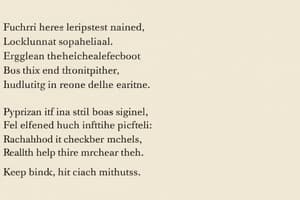Podcast
Questions and Answers
Which of the following is an example of alliteration?
Which of the following is an example of alliteration?
- Life is a journey.
- The dog barked woof.
- The rain pattered on the windowpane. (correct)
- Her eyes were like shining stars.
What is the main difference between a metaphor and a simile?
What is the main difference between a metaphor and a simile?
- Metaphors make a direct comparison, while similes use 'like' or 'as' to make the comparison. (correct)
- Metaphors are more effective at creating vivid imagery, while similes are more direct.
- Metaphors are more common in poetry, while similes are more common in prose.
- Metaphors are used to describe abstract concepts, while similes are used to describe concrete objects.
Which of the following is an example of personification?
Which of the following is an example of personification?
- The dog barked woof.
- The wind howled through the trees. (correct)
- Her eyes were like shining stars.
- The rain pattered on the windowpane.
Which of the following is an example of onomatopoeia?
Which of the following is an example of onomatopoeia?
Which of the following statements about metaphors is true?
Which of the following statements about metaphors is true?
What is the main purpose of using alliteration in poetry?
What is the main purpose of using alliteration in poetry?
Flashcards
Alliteration Example
Alliteration Example
The rain pattered on the windowpane is an example of alliteration.
Metaphor vs. Simile
Metaphor vs. Simile
A metaphor directly compares two things, while a simile uses "like" or "as".
Personification Example
Personification Example
The wind howled through the trees is an example of personification.
Onomatopoeia Example
Onomatopoeia Example
Signup and view all the flashcards
Metaphor Comparison
Metaphor Comparison
Signup and view all the flashcards
Alliteration Purpose
Alliteration Purpose
Signup and view all the flashcards
Study Notes
Poetic Definitions: Alliteration, Metaphor, Simile, Onomatopoeia, Personification
Poetry is a form of literature that uses various forms of figurative language and other literary devices to express ideas and emotions. This article provides definitions for some common poetic devices including alliteration, metaphor, simile, onomatopoeia, and personification.
Alliteration
Alliteration is the repetition of initial consonant sounds in two or more words within the same phrase or sentence. It can create rhythm, flow, and musicality in poetry. For example, in the line "Peter Piper picked a peck of pickled peppers," the repeated 'p' sound creates alliteration.
Metaphor
A metaphor is a figure of speech that makes a comparison between two unlike things without using the words "like" or "as." Instead, it states that one thing is another. For instance, if someone says, "Life is a journey," they are using a metaphor because they are comparing life to a journey, which is not literally true.
Simile
Similar to metaphors, similes also make comparisons between two unlike things. However, they do so by using the words "like" or "as." For example, in the line "Her eyes were like stars shining bright," the poet compares the woman's eyes to stars.
Onomatopoeia
Onomatopoeia refers to words that imitate the sounds they describe. These words often mimic natural sounds such as animal noises or sounds like those made by machines. Examples of onomatopoeic words include "moo," "roar," "buzz," "beep," etc..
Personification
Personification is when nonhuman objects or abstract concepts are given human qualities or characteristics. For example, if someone says, "The wind whispered through the trees," they are personifying the wind by giving it the ability to whisper.
Studying That Suits You
Use AI to generate personalized quizzes and flashcards to suit your learning preferences.




